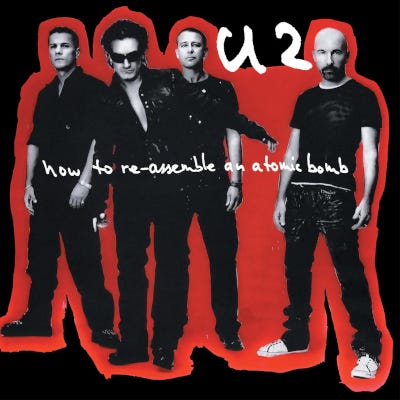Review - "How to Re-Assemble an Atomic Bomb" by U2
Released as a companion to 2004's "How to Dismantle an Atomic Bomb," U2 show us the equally impressive detail of what else was going on under the hood for the band in the early aughts.
“Love hears when I lie, love puts the blue back in my eye,
The sand inside the pearl, you were the luckiest man in the world…”
Possibly the most important band to my personal history with my deeply established love for music is U2. In my early teenage years, I wanted to explore my dad’s music collection for something new to listen to, and I knew that I liked the few songs by U2 that I had heard him play when I was a kid. The first thing I pulled from his collection was the album All That You Can’t Leave Behind by U2. And thus began the start of a new obsession - both with this band and with music as an art form generally.
To this day, I have U2 on fairly regular rotation every year, particularly their records out of the 80’s and 90’s when they were at their finest. The sad part about U2, unfortunately, is that nothing they’ve released in the past fifteen years quite measures up to their early work. I consider 2004’s How to Dismantle an Atomic Bomb to be their last truly great effort with the three albums that followed to be only just alright in comparison to what history has shown the band to be capable of. Well, it’s been twenty years since the release of How to Dismantle an Atomic Bomb and this year U2 decided to commemorate it’s release by dropping a companion album of B-sides written and recorded during the Dismantle sessions. That companion album is aptly titled How to Re-Assemble an Atomic Bomb. It’s not a traditional album by any means, and I didn’t intend to review it initially, but it’s been such a welcome callback to the old days of U2 that I decided it deserves it.
U2’s roots lie in 1970’s punk rock - The Ramones, The Clash, The Sex Pistols to name a few - and their early work reflects it. Throughout the early 80’s, U2 defined themselves as one of the earliest and most important post-punk acts, taking the raw sound and political protests of punk rock and cleaning it up just enough to recognize the punk roots without sounding overtly like a punk rock band. Over the years since, U2 has taken many forms, but they’ve become more and more polished with each passing decade. And that might be where their new work lacks the same power they used to have - it’s almost too polished at this point. What made How to Dismantle an Atomic Bomb truly great in the band’s third decade together was its return to the gritty refinement of early post-punk - a sound that (to me) is a beautiful callback to 1987’s The Joshua Tree, a masterfully written record and one of my all-time favorite albums. The companion record, How to Re-Assemble an Atomic Bomb, mirrors this sound from Dismantle, but it’s far more raw. Such is to be expected of a collection of B-sides, I suppose.
The release of How to Re-Assemble an Atomic Bomb this year felt like being given the gift of new music from classic U2. For a band that hasn’t made much of an impression on me in many years in the way of new music, this companion record was an unexpected gem and excellent expansion to an outstanding record, showing that there is still more to hear under the hood. Where Dismantle has refined grit, Re-Assemble is less refinement and more grit. It boldly opens with an alternate (and far more raw) version of “Fast Cars” off the original record, listed under the name “Picture of You (X+W),” with quality more akin to a demo than a studio recording. Re-Assemble continues with the messy and loud “Evidence of Life” and later on with unique tracks like “Treason” and “Happiness” the latter of which includes less singing and more punk-style yelling than we’ve heard from U2 in a very, very long time. And then there’s the refined side of the record with “Luckiest Man in the World” and “Country Mile” both sounding like they were directly cut from the early versions of Dismantle or even The Joshua Tree. It’s a well-rounded record, really, demonstrating multiple sides of what made How to Dismantle an Atomic Bomb a great record in the first place. And this companion record ends where it began with a messier-than-the-original reworking of another Dismantle track, “All Because of You,” with the alternate version simply titled “All Because of You 2.”
Overall, How to Re-Assemble an Atomic Bomb has been, for me, continued evidence that this band is legendary for a reason. After years of not expecting much in the way of new music, they’ve given us something refreshingly bold, even if it’s just a collection of tracks pulled from the archive from two decades ago. It’s great companion record that all true U2 fans absolutely need to hear and definitely will enjoy. I know that, for me, this will likely go into my regular rotation with the rest of their vast catalog.
Overall Rating: 7.6/10
Top Tracks:
- Luckiest Man in the World
- Country Mile
- Happiness
Listen to this album if you like:
- 1980’s era U2
- Excellent B-sides collections
- Good reasons to get back into U2 again after all this time





